

FIRST PRINTING
December 1918
| ||
| Click on image to get a more detailed view. |

|
In the early 1900's Latvia was part of tsarist Russia. But after the Russian Revolution of 1917 Latvia declared its independence on November 18, 1918. Soon after its independence Latvia issued its first postage stamps on December 18, 1918. Latvia's first stamp had a design of a rising sun with 3 ears of wheat within a ring. It was designed by Ansis Cīrulis, a Latvian graphic artist and painter. It was available in two forms: imperforate (1,600,00 printed) or perforated 111/2 (1,125,968 printed). It was printed by A. Schnakenburg of Riga in single color (carmine) lighography. Because of paper shortages the first stamps were printed in sheets of 228 (19 x 12) on the backs of German military maps. Topographic maps were published by the Prussian military at the turn of the 20th century at a scale=1:100,000). The set was based on Russian and Austrian maps and was not an original survey. A full set of the maps was about 470 sheets but according to the book "Lettland: Handbuch Philatelie und Postgeschiechte - Die Briefmarken in Rubel-Währung 1918 - 1922" the Latvian stamps were only printed on 79 of them. A number of them can be seen on the Lithuanian Maps site. The maps were identified by a letter-number combination with a city name. Most major stamp catalogs (Scott, Michel, Stanley Gibbons, Yvert & Tellier, Zumstein), classify these two stamps as #1 (imperforate) and #2 (perforated). The Michel catalog expands upon this classification by perforation to also classify the stamp according to what is on the reverse side. The German military maps were printed in black and brown ink. As you can see from the view of the total map there was also a large area on the sides of the map that had no printing. Michel therefore breaks down the stamp numbering as
 |
 |
 |
| 1 I Black & brown |
1 II Black only |
1 III No printing |
 |
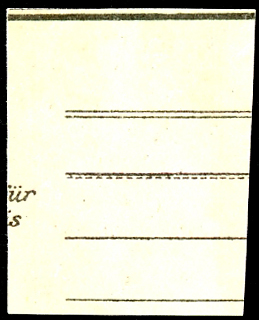 |
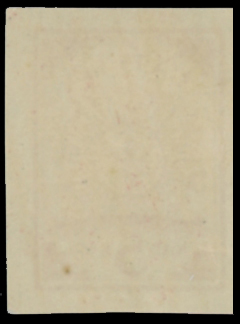 |
 |
 |
 |
| 2 I Black & brown |
2 II Black only |
2 III No printing |
 |
 |
 |
SECOND PRINTING
January 1919
The Latvian Provisional Government was created on November 18, 1918 and it was immediately challenged by a Soviet Union led take over. The Provisional government had to move out of Riga to the city of Liepaja. This movement of the government impacted the Post Office also. The original printing plates were left behind and new plates had to be prepared, new paper sources had to be found along with a new printer. The new printer for the stamps was Gottlieb D. Meyer of Liepaja and the paper used was just ordinary white, ruled paper. There are a number of small differences between the original plates and the new plates produced in Liepaja.
 |
1918
|
 |
1919
|
The 1919 printing of the "sun" design was also available in 2 additional values and colors: a blue 10 Kap. and a green 15 Kap. It was not until August of 1922 that Latvia had its own money (1 lats = 100 santims). Until then Latvia used Russian money (1 rublis = 100 kapeiku) and thus the abbreviation of Kap. on the stamps. As with the 1918 printing the stamps were available imperforate and perforated 111/2. An additional way to recognize the 1919 printing of the stamps is that the stamps were printed on ruled paper, not German military maps. On the reverse side of the stamp you can see very fine horizontal lines as shown below.
 |
 |
 |
 |
 |
 |
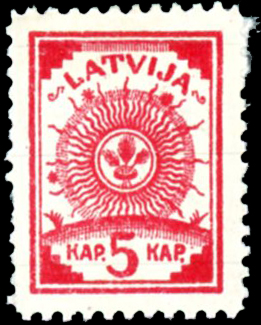 |
 |
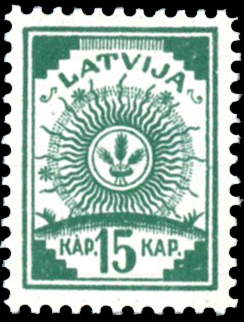 |
 |
 |
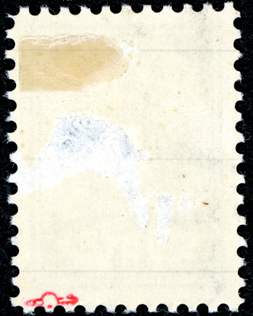 |
THIRD PRINTING
February 1919
By February of 1919 another printing of the stamps was required. Not only did they need to reprint the 5, 10 and 15 Kap stamps but they added 6 more values: 3, 20, 25, 35, 50 and 75 Kap. These stamps were available in perforated and imperforate form except for the 25 Kap stamp. That was available only imperforate. And again there was a paper change. Instead of the stamps being printed on German miltary maps or ruled paper the were printed on pelure paper or sometimes called "cigarette" paper. This type of paper could be identified by looking at the reverse side of the stamp and easily seeing through the paper to the front design as shown below.
 |
 |
 |
 |
 |
 |
 |
 |
 |
 |
 |
 |
In addition to the above 3 values the third printing added the following 6 values. All of the values except the 25 Kap. were available imperforate or perforated 111/2. Scott has a note in its catalog that the stamps perforated 111/2 were "unofficially" perforated. The 25 Kap. stamp was only available imperforate.
 |
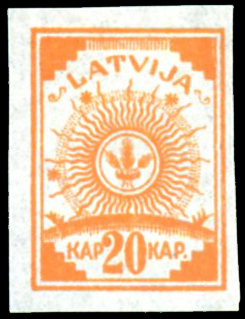 |
 |
 |
 |
 |
 |
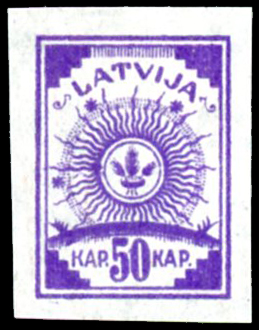 |
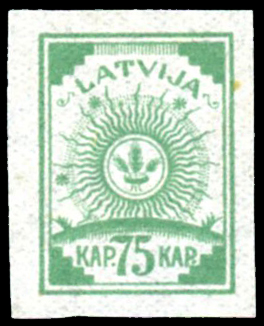 |
 |
 |
 |
 |
 |
 |
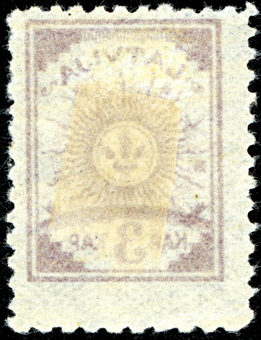 |
 |
|
 |
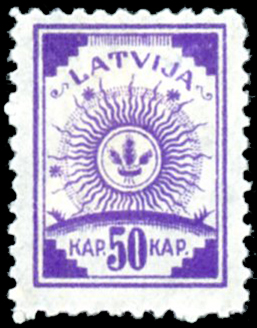 |
 |
 |
 |
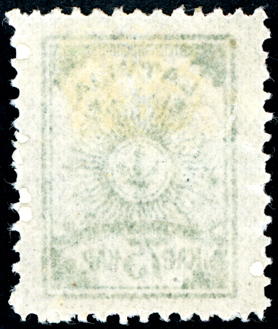 |
There was one more "wrinkle" to the third printing. Many stamps from this printing can be found imperforate on 3 sides and perforated 91/2 or 93/4 either on the top or bottom of the stam. From "Lettland: Handbuch Philatelie und Postgeschiechte - Die Briefmarken in Rubel-Währung 1918 - 1922", page 67.
Printed in sheets of 400, each of which consists of four counter sheets of 100. Each counter sheet consists of two half-sheets of 50 separated by a horizontal line of perforation gauging 93/4. It therefore follows that ten stamps on each sheet are perforated 93/4 at the bottom and ten with this gauge at the top.
Scott acknowledges the the existance of these stamps in a round about way in that they list two perforations (111/2 or 93/4) for these stamps. However they just assign one number to these stamps. Michel assigns 1 number to the stamps but it assigns the suffix A for stamps perforated 111/2 on all sides, the suffix B to imperforate stamps with either the top or bottom perforated 93/4 and suffix C for imperforate all sides.
 |
 |
 |
 |
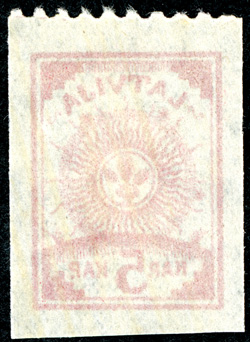 |
 |
 |
 |
 |
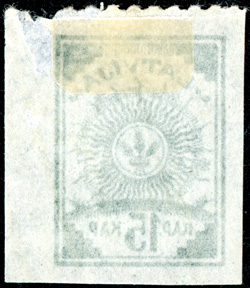 |
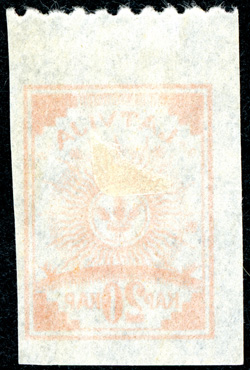 |
25 Kap. |
 |
 |
 |
 |
 |
 |
 |
 |
 |
 |
 |
 |
 |
 |
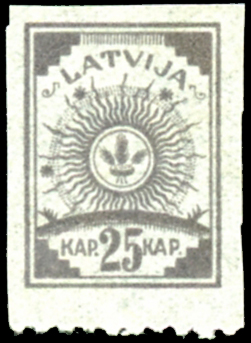 |
 |
 |
 |
 |
 |
 |
 |
 | >
 | >
FOURTH PRINTING
April 1919
In April of 1919 the sun design stamps were reprinted again. All 9 values were reprinted with the only change being that they used paper with a honeycomb watermark. The stamps were available imperforate only and were never perforated.
 |
 |
 |
 |
 |
 |
 |
 |
 |
 |
 |
 |
 |
 |
 |
 |
 |
 |
Just as the third printing, the fourth printing was done in sheets of 400, each of which consisted of four counter sheets of 100. Each counter sheet consisted of two half-sheets of 50 separated by a horizontal line of perforation gauging 93/4. It therefore follows that ten stamps on each sheet were perforated 93/4 at the bottom and ten with this gauge at the top.
 |
 |
 |
 |
 |
 |
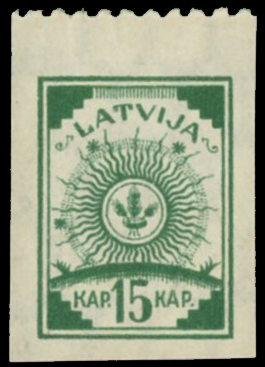 |
 |
 |
 |
 |
 |
 |
 |
 |
 |
 | >
 | >
 |
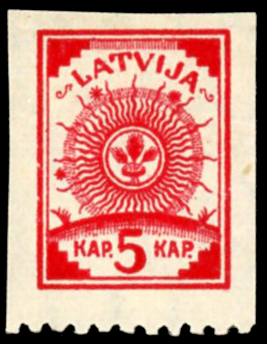 |
 |
 |
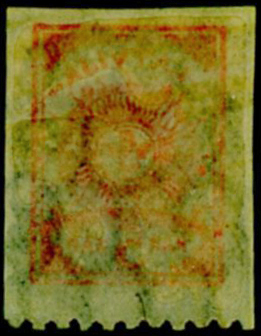 |
 |
 |
 |
 |
 |
 |
 |
 |
 |
 |
 |
 | >
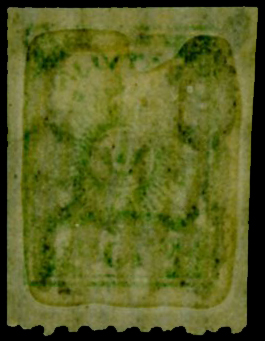 | >
ADDITION OF HIGH VALUES
November 1919
The printing of the stamps was finally moved back to Riga. These stamps were printed by the State Printing House. They were printed on paper that was not watermarked and they were not issued in imperforate form.
 |
 |
 |
 |
FIFTH PRINTING
May 1920
This is the last time this design of stamp was printed. In the book "Lettland: Handbuch Philatelie und Postgeschiechte - Die Briefmarken in Rubel-Währung 1918 - 1922" printed by Harry v. Hoffman, 1998, on page 154, the 5th printing of this design is introduced and the book says, “Same design as for the second, third and fourth issue of the sun design.” And in the same introduction the book also says that the stamps were printed by the State Printing House, Riga. Later, on page 157, the book says “The 5 kap. value was printed on Riga stones. All other values were printed on Liepaja stones, taken from the Liepaja firm G. D. Meyer to the state printing works.” This means that the 5 kap. design shows the "bush" in the lower left corner with 4 branches and the other values show the "bush" with 5 branches. All the stamps were printed on paper that was not watermarked and they were not issued in imperforate form.
 |
 |
 |
 |
 |
 |
 |
 |
 |
 |
 |
 |
100th anniversary of the printing of the first Latvian stamp
November 2018
The obvious give-aways are the €0.54 denomination and the addition of the years 1918 and 2018 in the lower left and right corners respectively of the stamp. The stamp was designed by Ģirts Grīva and printed by Baltic Banknote of Riga, Latvia. In all 150,000 stamps were printed.
 |